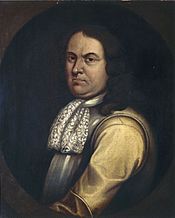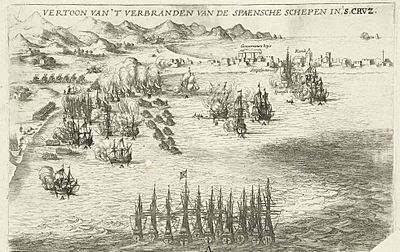Battle of Santa Cruz de Tenerife (1657) facts for kids
Quick facts for kids Battle of Santa Cruz de Tenerife |
|||||||
|---|---|---|---|---|---|---|---|
| Part of Anglo-Spanish War (1654–1660) | |||||||
 Robert Blake's flagship George at the battle of Santa Cruz de Tenerife in 1657. |
|||||||
|
|||||||
| Belligerents | |||||||
| Commanders and leaders | |||||||
| Strength | |||||||
| 2 galleons, 9 merchant ships, 5 other vessels, 1 castle and various shore gun emplacements |
23 warships | ||||||
| Casualties and losses | |||||||
| 12 ships sunk, 5 captured 300 killed |
1 ship severely damaged, 48 killed & 120 wounded |
||||||
The Battle of Santa Cruz de Tenerife was an important naval battle. It happened on April 20, 1657, during the Anglo-Spanish War (1654–60). An English fleet, led by Admiral Robert Blake, sailed into the well-protected harbour of Santa Cruz de Tenerife. This port is in the Spanish Canary Islands.
Blake's goal was to attack the Spanish treasure fleet. The valuable treasure had already been taken off the ships and was safe on land. However, the English still fought the forts in the harbour and the Spanish ships. Many Spanish ships were sunk on purpose, and others were burned. After achieving his goal, Admiral Blake left the harbour without losing any of his own ships.
Contents
Why Did the Battle Happen?

In 1654, England decided to join France in its war against the Spanish Empire. At this time, England was ruled by the Protectorate, led by Oliver Cromwell. England hoped to gain wealth by attacking Spanish lands, especially in the West Indies.
War was officially declared in October 1655. An English attempt to capture the Spanish colony of Santo Domingo failed. So, England turned its focus to Europe. One major plan was to block the Spanish port of Cadiz. Admiral Robert Blake was put in charge of this important task.
Blake's Strategy and the Spanish Treasure Fleet
Admiral Blake kept his fleet at sea for an entire winter to block Cadiz. During this time, one of Blake's captains, Richard Stayner, destroyed a Spanish convoy. More English ships arrived as backup in late 1656, including the George, which became Blake's main ship.
In February 1657, Blake learned that the Spanish treasure convoy from Mexico was sailing across the Atlantic. Even though his captains wanted to find the Spanish galleons right away, Blake waited. He wanted to keep his forces together. After getting supplies, Blake left Cadiz on April 13, 1657. He sailed to attack the treasure fleet, which was waiting at Santa Cruz de Tenerife for an escort to Spain.
Preparing for the Attack
Blake's fleet reached Santa Cruz on April 19. Santa Cruz is in a deep bay. The harbour was protected by a strong castle, Castle of San Cristóbal (Santa Cruz de Tenerife), with forty guns. There were also smaller forts and walls to protect musketeers.
Blake planned his attack carefully. He sent twelve fast ships, called frigates, under Rear-Admiral Stayner in Speaker. Their job was to enter the harbour first and attack the galleons. Blake would follow in his ship, George, with the rest of the fleet. Their role was to bombard the forts on the shore.
The Battle Begins
The attack started at 9:00 AM on April 20, 1657. Stayner's ships moved close to the Spanish ships. This helped protect the English ships from the guns of the castle and forts. The English ships did not fire until they were in position and had dropped anchor.
While the frigates attacked the Spanish galleons, Blake's heavier warships sailed into the harbour. They began firing at the shore defenses. Blake gave a clear order: no Spanish ships were to be captured. The entire Spanish fleet had to be destroyed.
Destroying the Spanish Fleet
Most of the Spanish fleet were smaller merchant ships armed for defense. They were quickly defeated by the powerful guns of Stayner's warships. The two large galleons fought for several hours. Blake's ships cleared the walls and smaller forts. The smoke from the gunfire and burning ships actually helped the English. It made it harder for the Spanish forts to see and hit their ships.
Around noon, the main ship of the Spanish admiral, Don Diego de Egues, caught fire. Soon after, it exploded when its gunpowder storage blew up. English sailors used small boats to board Spanish ships and set them on fire. By 3:00 PM, all sixteen Spanish ships in the harbour were either sunk, burning, or had given up. Some reports say twelve Spanish merchant ships survived.
Against orders, Swiftsure and four other frigates tried to take captured Spanish ships as prizes. Blake sent strict orders that these captured ships must be burned. He had to repeat his order three times before the captains finally obeyed.
Leaving the Harbour Safely
After destroying the Spanish ships, the English fleet faced a dangerous task. They had to leave Santa Cruz harbour while still under fire from the forts. It was said that the wind suddenly changed direction, helping Blake's ships sail out of the harbour. However, this story might be a misunderstanding.
The English fleet actually pulled itself out to the open sea by using ropes and anchors. This clever tactic was something Blake had used before. Speaker, the first ship to enter the harbour and the last to leave, was badly damaged. But amazingly, no English ships were lost in the battle.
What Happened Next?
The Spanish treasure from Mexico had been unloaded and was safe on land. Blake could not capture it. However, it was also not available to the Spanish government in Madrid right away. This battle is seen by English historians as a major victory and one of Blake's greatest achievements. He had entered a heavily defended harbour, burned twelve Spanish ships, and destroyed five others that were captured. Blake's forces only lost 48 men killed and 120 wounded.
News of the battle reached England the next month. It was celebrated as a huge victory. On May 28, Parliament decided to give Blake a valuable jewel worth £500. This was a very high reward, similar to what General Thomas Fairfax received for his victory at the Battle of Naseby in 1645. Stayner was made a knight by Oliver Cromwell.
Blake was ordered to return home in June. He made one more trip to Salé in Morocco. There, he successfully made a deal to free English slaves. He returned to Cadiz in mid-July and gave command of the fleet to his captain, John Stoakes. Blake then sailed for England with eleven ships that needed repairs. However, Blake's health was failing. He died aboard his flagship George on August 7, 1657, as his fleet neared Plymouth Sound.
The victory at Santa Cruz de Tenerife greatly improved the reputation of Cromwell's navy across Europe. Some of the Santa Cruz treasure was later captured when a Dutch ship trying to break the blockade of Cadiz was seized.
Eventually, the Spanish commanders Egües and Centeno transported the treasure to Spain on March 28, 1658. King Philip of Spain congratulated them for safely delivering the treasure, which Spain saw as a victory. He rewarded them with money.
Ships Involved in the Battle
Blake's fleet had 22 ships:
The Spanish fleet had two main warships:
- Jesús María, commanded by D. Diego de Egües
- Concepción, commanded by D. José Centeno
See also
 In Spanish: Batalla de Santa Cruz de Tenerife (1657) para niños
In Spanish: Batalla de Santa Cruz de Tenerife (1657) para niños


